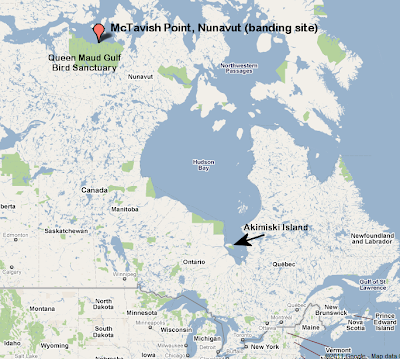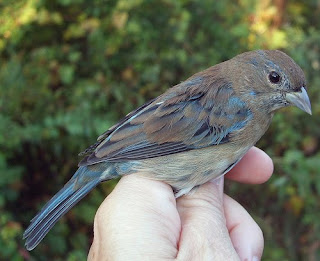The spring 2010 survey season took place on 47 days between 1 April through 4 June. There were surveys on most mornings in April and nearly every day in May except during heavy rain. As in past years, each survey always included a 1.5-mile standard route in the natural area on campus. Many days, additional area was covered; distance, time, and birds counted on these legs were recorded separately but are discussed below in aggregate.
On campus,
129 species were recorded (another 9 were recorded in Dearborn off-campus). This equals the previous 12-year mean. The peak calendar week was 16 through 22 May with 92 species. This is the same peak week as 2009, but last year 95 species were recorded that week. The peak day was 16 May (18 May last year) with 76 species (ten fewer than 2009).
Weather
The National Weather Service reported that 2010 had the warmest spring on record for Detroit, and the warmest spring since 1991 across most of the southern Michigan region. This was largely due to warm temperatures in March and April (both months in the top 20 warmest lists for southeast Michigan). The first week in April was particularly hot -- the warmest first week in April in climate history at Detroit, Flint, and Saginaw. However, there were below-average temperatures the second week in May. At Detroit much of the spring was dry, with precipitation well below average through the end of April. Rain in May helped boost precip levels up and much of the region was near-normal by the end of May. These weather patterns were guided by a jet stream that was generally south of our region up until May.
General trends
One inevitable result of warm weather early in the spring is that trees leaf out earlier, making detecting birds more difficult. While most spring birds are recorded by hearing them sing, this obviously doesn't work with silent birds, especially females. The understory here on campus is now dominated in most areas by non-native shrub genera that also tend to leaf out early:
Lonicera (honeysuckles) and
Rhamnus/Frangula (buckthorns). These hindrances to detectability may have played a role in overall low numbers of many species of migrants, and late season migrants in particular. Species that make up the caboose of spring migration here, such as both cuckoos and
Blackpoll, Canada, and
Mourning Warblers, were found only in very modest numbers over a period of just a few days.
I hope that detectability, favorable weather promoting migration past our site, or some other benign factor was responsible for the lack of late-season migrants. We will probably never know if the burning of oil from the
Deepwater Horizon catastrophe in the Gulf disoriented, sickened, or killed migrant songbirds. Whether it did or not, we can only wait and see how it effects southbound migrants, directly or indirectly. As of this writing, unknown thousands of barrels of oil are still belching from the sea floor. Right now, our minds are with the waterbirds, sea creatures, and humans that are being immediately and urgently impacted by these malignant plumes of oil. I'm sure we have yet to imagine the profound and far-reaching impacts this disaster will have on wildlife -- maybe even migrant songbirds -- in the years to come.
Already troubling to me is the apparent decline in the number of individuals of some common species.
Black-throated Blue Warbler, Black-and-white Warbler, American Redstart, and
Ovenbird are good examples. The number of individuals of each of these species posted a greater than 30% decline over the average number counted the previous three years. This ranged from 33% fewer redstarts to 57% fewer Black-throated Blue Warblers. These numbers have not been adjusted for effort, but effort has been similar the past four years, hence the short time frame given. In a few more months, 17 years of daily spring surveys with effort data will be digitized and available for analysis, providing a much clearer picture. But even this back-of-the envelope calculation may be cause for alarm, as this suite of species has something in common: they all winter primarily in the West Indies.
John Faaborg's excellent long-term winter banding project in Puerto Rico has noted very alarming declines in some of the most common wintering North American migrants on his study plot -- and both Black-and-white Warbler and Ovenbird have declined to less than 20% of their original abundances since 1973.
Migrant birds have complex life histories, so it is hard to draw conclusions from one year and one place. If you are interested in the struggle to understand how to monitor and evaluate migratory songbirds, I recommend this excellent overview (PDF):
Conserving migratory land birds in the New World: Do we know enough? Ecological Applications 20:398-418.
You don't need a lot of technical chops in bird ecology to get the gist of what we are up against when you read this paper.
You can help! There is power in large amounts of data. For this reason, I encourage all readers to consider contributing their past and future bird data to
eBird. I believe this is our best hope for strong evidence to shape conservation of birds for decades to come.
Back to spring 2010...
Arrival dates
Only a few species posted record early spring arrival dates this year.
Blue-gray Gnatcatchers arrived on 8 April, four days earlier than the previous early date. On 15 April, a
Blue-headed Vireo showed up, four days early. When they were recorded on 16 April,
Chimney Swifts were two days early.
I keep track of the arrival dates of over 40 species of conspicuous (easily detectable) migrant species. About half of these species arrived earlier this year than the previous 16-year mean (an average of 4 days earlier), while about half arrived later (average 3 days later).
More interesting, perhaps, is comparing the 2010 arrival date with the mean for the first 7 years (for most species, 1993-1999). In 2010, 62% of species arrived earlier than they did during the early 1990s, an average of 5 days earlier. The 31% that arrived later did so on average of 3 days later.
If we look at this group of species and compare the early period (for most species, 1993-1996) with the current period (2003-2010), the trend toward earlier arrivals is even more pronounced. Nearly 79% of species are arriving earlier (by an average of 4 days), while less than 17% are arriving later (3 days). This method uses arithmetic means, and more rigorous statistical testing over longer time periods will be done once digitization of all years of spring survey data is complete.
Highlights
Notable birds were rather few and far between this year. No outstanding rarities were recorded. A number of less common species were found on campus:
Common Loon (flyover, 15 Apr),
American Coot (7 Apr),
Sandhill Crane (flyover, 5 May),
Red-headed Woodpecker (5 May),
White-eyed Vireo (25 and 30 May, probably the same bird),
Hooded Warbler (6 and 21 May),
Summer Tanager (14 and 19 May), and
Orchard Oriole (1 May, and another bird that arrived on 23 May and was present through the end of May).
Perhaps more notable were the birds not recorded. For the first time in 18 years, we did not record any
Blue-winged Warblers, normally a common species. Other species that are annual here but were missed this year --
Philadelphia Vireo, Orange-crowned Warbler, and
Connecticut Warbler -- can be difficult to find and have often been picked up during banding operations versus surveys. Because we do not currently have a spring research project that can be addressed by the capture of birds, we did not band birds again this spring and so did not record these species.
Many thanks to Darrin O'Brien and Jerry Sadowski, who assisted with surveys this spring.












































